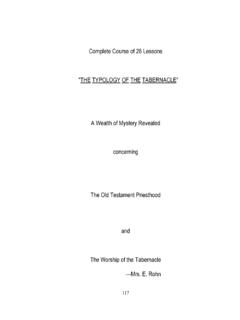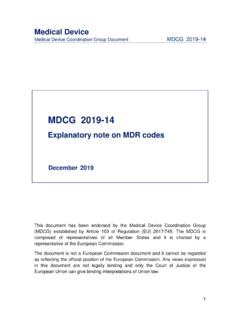Transcription of HC3.1. HOMELESS POPULATION
1 OECD Affordable Housing Database OECD - Social Policy Division - Directorate of Employment, Labour and Social Affairs Last updated on 24/07/2017 HOMELESS POPULATION Definitions and methodology This indicator presents available data at national level on the number of people reported by public authorities as HOMELESS . Data are mainly taken from the 2016 OECD Questionnaire on Affordable and Social Housing (QuASH 2016). Overall, 29 out of 35 reporting countries provided data on the number of HOMELESS (See Table HC in Annex I below). There is no internationally agreed definition of homelessness. Therefore, this indicator presents a collection of available statistics on homelessness in OECD and EU countries in line with definitions used in national surveys (comparability issues on the data are discussed below). Some countries have different official definitions of HOMELESS : they may use a definition for the purpose of data collection but use another one or several definitions for policy purposes, in the framework of policy measures aimed at tackling homelessness.
2 In this indicator we refer only to the statistical definition used for data collection purposes. Detail on what is included in the number of HOMELESS , the definition used for statistical purposes, is presented in Table HC at the end of this indicator. To facilitate comparison of the content of HOMELESS statistics across countries, it is also indicated whether the definition includes the following categories (based on ETHOS Light , see Box ): People living Rough: Living in the streets or public spaces without a shelter that can be defined as living quarters People in emergency accommodation: People with no place of usual residence who move frequently between various types of accommodation People living in accommodation for the HOMELESS : Including HOMELESS Hostels; temporary accommodation; Transitional Supported Accommodation; Women s shelter or refuge accommodation People living in institutions: Including people who stay longer than needed in health institutions needed due to lack of housing.
3 And people in penal institutions with no housing available prior to release People living in non-conventional dwellings due to lack of housing : where accommodation consists of mobile homes, non-conventional building or temporary structure, and is used due to a lack of housing and is not the person s usual place of residence People living temporarily in conventional housing with family and friends due to lack of housing Other: elements linked with the person s living conditions or status not included above, according to which he/she is counted as HOMELESS OECD Affordable Housing Database OECD - Social Policy Division - Directorate of Employment, Labour and Social Affairs Last updated on 24/07/2017 Key findings Homelessness counts in most countries include rough sleepers, people living in accommodation for the HOMELESS and in emergency temporary accommodation, but definitions of homelessness vary across countries.
4 Statistics from all countries include rough sleepers, except for data on Austria, Estonia, and Slovenia where rough sleepers are not separately identifiable. Data in most countries (22 countries) cover people living in accommodation for the HOMELESS and people living in emergency accommodation (21 countries). About half of the surveyed countries also cover people living in non-conventional dwellings and people living temporarily with family and friends due to lack of housing, while only 7 countries also include people living in institutions in their homelessness statistics. Details are provided in Table HC , in Annex I. In all countries less than 1% of the POPULATION is reported as HOMELESS . As shown in table HC below, the number of people reported as HOMELESS accounts for less than 1% of the POPULATION in all responding countries. Australia, the Czech Republic and New Zealand report a relatively large incidence of homelessness, and this is partly explained by the fact that these countries adopt a broad definition of homelessness.
5 In Australia people are considered as HOMELESS if they have no other options to acquire safe and secure housing are without shelter, in temporary accommodation, sharing accommodation with a household or living in uninhabitable housing . In the Czech Republic the term HOMELESS covers persons sleeping rough (roofless), people who are not able to procure any dwelling and hence live in accommodation for the HOMELESS , and people living in insecure accommodation and people staying in conditions which do not fulfil the minimum standards of living [..] . In New Zealand homelessness is defined as living situations where people with no other options to acquire safe and secure housing: are without shelter, in temporary accommodation, sharing accommodation with a household or living in uninhabitable housing. The country with the smallest share of HOMELESS persons is Japan ( of the POPULATION in 2015) where figures only refer to people sleeping rough.
6 For further information on the national definitions used to collect data on homelessness, see Table HC Although the HOMELESS are a small share of the POPULATION , these figures still represent a significant number of people. Among the higher reported figures, the United States report 564,708 HOMELESS people, and Canada, France and Australia all report having over 100 thousand HOMELESS people in their most recent surveys. OECD Affordable Housing Database OECD - Social Policy Division - Directorate of Employment, Labour and Social Affairs Last updated on 24/07/2017 Table HC : Estimated number of HOMELESS people, 2015 or latest year available 1 Year Number of HOMELESS HOMELESS as % of total POPULATION Figures include more than persons 1) living rough, 2) living in emergency accommodation, and 3) living in accommodation for the HOMELESS ? Australia 2011 105,237 Yes Austria 2014 14,603 No Canada 2011 150,000 No Chile 2011 12,255 No Croatia 2013 462 No Czech Republic (3) 2015 68,500 Yes Denmark 2013 6,138 Yes Estonia 2011 864 Yes Finland 2015 7,200 Yes France 2012 141,500 No Germany (4) 2014 335,000 Yes Greece 2009 21,216 Yes Hungary 2014 10,068 Yes Ireland 2015 3,625 No Italy (5) 2014 50,724 No Japan 2015 6,235 No Latvia 2011 2,342 Yes Lithuania 2011 857 No Luxemburg 2006 715 Yes Mexico 2010 40,911 Yes Netherlands 2015 31,000 Yes New Zealand 2015 41,207 Yes Norway 2012 6,259 Yes Poland 2015 36,161 Yes Portugal 2009 2,133 No Slovenia 2015 2,700 No Spain 2012 22,938 No Sweden 2011 34,000 Yes United Kingdom (6) 2015-16 (57,750 households) (households) Yes, but limited to certain priority categories United States 2015 564,708 Yes 1.
7 Information is missing for Belgium, Bulgaria, Cyprus, Iceland, Israel, Italy, Korea, Malta, Romania, the Slovak Republic, Switzerland and Turkey. 2. 2. refers to POPULATION on first of January of the year of reference, see OECD POPULATION and vital statistics database, 3. Czech Republic: an additional 119,000 people are considered at risk of homelessness, including persons living in unsuitable conditions ( atypical, informal residential buildings) and legally insecure housing. 4. Germany: no official statistics are available at federal level on the number of HOMELESS . Figures in table HC refer to estimates published yearly by the Federal Association for the Support of HOMELESS (Bundesarbeitsgemeinschaft Wohnungslosenhilfe , or BAG W). The Federal Government regularly refers to these figures in its reports on poverty and wealth since 2001. 5. Italy: Based on a survey carried out among HOMELESS service users in 158 municipalities.
8 The number of HOMELESS people reported represents of the POPULATION registered as resident in the surveyed municipalities. OECD Affordable Housing Database OECD - Social Policy Division - Directorate of Employment, Labour and Social Affairs Last updated on 24/07/2017 6. United Kingdom: Data refer to England only. They refer to the number of households applying for housing assistance to local authorities who are accepted as statutory HOMELESS during the year of reference. Sources: OECD Questionnaire on Affordable Housing, 2016; for Denmark, information was retrieved from the 2014 OECD Questionnaire on Social and Affordable Housing and figures updated using the same source (Benjaminsen, L., and Lauritzen, H. H., 2015); for Italy: ISTAT (2014), Le persone senza dimora. Homelessness has increased in recent years in Denmark, England, France, Ireland, Italy, the Netherlands and New Zealand, but fallen in Finland and the United States Although comparability of data across countries is limited (see Data and comparability issues, below), it is possible to identify trends in homelessness within some OECD countries, based on available information from national sources.
9 A number of countries have experienced an increase in homelessness in recent years, namely Denmark, England, France, Ireland, the Netherlands, and New Zealand. In Denmark, the most recent HOMELESS survey (Benjaminsen and Lauritzen, 2015) shows that there were there were 6,138 HOMELESS people in Denmark in the first week of February 2015, up from 5,820 in 2015 and 4,998 in 2009. The number of HOMELESS youth aged between 25 and 29 has increased significantly. Furthermore, about one-half of the HOMELESS have been HOMELESS for less than a year, showing a continued influx of newly HOMELESS people into the statistics. In England local authorities have a statutory duty under the Housing ( HOMELESS Persons) Act of 1977 to secure suitable accommodation for unintentionally HOMELESS households who are in a priority need category. The latter include, for instance, people with dependent children, people who are HOMELESS as a result of emergencies such as flood, fire or other disasters, pregnant women, persons who are vulnerable because of old age, mental illness or disability, vulnerable care leavers, and persons fleeing violence.
10 Data on HOMELESS requests for accommodation and acceptances are regularly produced by local authorities and published by the Department for Communities and Local Government (DCLG). Although DCLG also publishes statistics on rough sleeping and on prevention and relief efforts by local authorities, the UK Statistics Authority in a recent report (UK Statistics Authority, 2015) concluded that that only the statutory HOMELESS figures could be considered national statistics . Data on statutory homelessness show there has been a significant increase in HOMELESS acceptances over the past five years, from 50,290 households in 2011-12 to 57,750 in 2015-16 (DCLG, 2016). In France, figures on homelessness were collected by INSEE in 2001 and 2012 through a survey among users of HOMELESS shelters and centers for meals distribution, in agglomerations of more than 20,000 inhabitants, during a week between January and March.


















